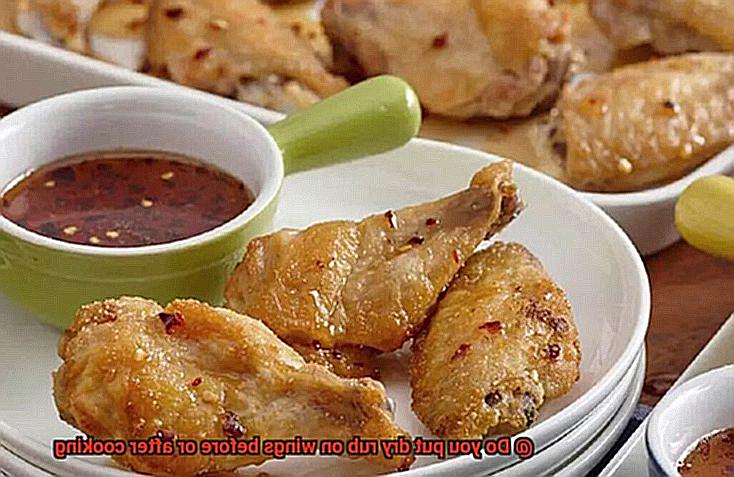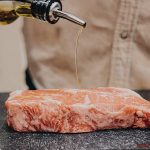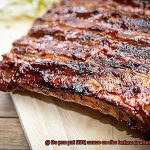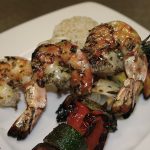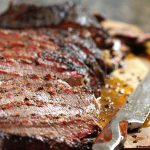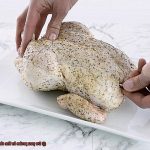Chicken wings are a classic crowd-pleaser, perfect for game day snacking or backyard barbecues. But what really sets them apart is the addition of a dry rub. That blend of herbs, spices, and seasonings can transform an ordinary wing into something truly special. However, there’s one question that always sparks debate: should you apply the dry rub before or after cooking?
Some folks swear by pre-cooking seasoning to really infuse the meat with flavor. Others argue that post-cooking application keeps the wings from drying out. It’s a divisive issue, but one thing is clear: getting that dry rub just right can make all the difference in your chicken wing experience.
So what exactly is a dry rub? It’s a blend of spices and other seasonings that get applied directly to the surface of the meat before cooking. The ingredients and proportions can vary depending on personal preference and desired flavor profile, but common additions include paprika, garlic powder, cayenne pepper, and brown sugar.
Now let’s dive into the pros and cons of both pre- and post-cooking seasoning methods so you can decide which one works best for you.
Contents
What is a Dry Rub?
If you’re searching for a way to elevate the flavor of your meats, look no further than a dry rub. A dry rub is a blend of herbs, spices, and seasonings that are applied directly to the surface of the meat before cooking. This seasoning blend is called “dry” because it doesn’t require any liquid or marinade to adhere to the meat.
Dry rubs are versatile and can enhance the flavor of various types of meats, such as pork, beef, and chicken wings. The ingredients used in a dry rub can vary widely depending on personal preference and the desired flavor profile. Some common ingredients include salt, sugar, black pepper, garlic powder, onion powder, cumin, paprika, and cayenne pepper.
One of the significant benefits of using a dry rub is that it creates a flavorful crust on the meat when cooked. This crust adds texture and enhances the overall flavor of the meat. Dry rubs pair well with other cooking methods like grilling, smoking, or roasting.
When it comes to chicken wings, applying the dry rub before or after cooking depends on personal preference and cooking method. If you’re grilling or smoking the wings, it’s best to apply the dry rub before cooking to allow the flavors to penetrate the meat while it cooks. However, if you’re baking or frying the wings, it may be better to apply the dry rub after cooking for a crispy texture on the outside.
To ensure even coating of your wings with seasoning, place them in a bowl and toss them with the dry rub mixture or place them in a plastic bag and shake until coated.
Lastly, using high-quality dry rub is essential to achieve your desired flavor profile. Some blends contain salt that should be applied sparingly as too much salt can draw out moisture from the meat and make it tough.
Different Types of Dry Rubs
Spice things up with the help of dry rubs. These flavorful blends of herbs, spices, and sometimes even sugar can take your wings to the next level. Below are five different types of dry rubs you can use to achieve unique and delicious flavor profiles.
Sweet and Spicy
Looking for a little bit of heat with a touch of sweetness? A sweet and spicy dry rub is the way to go. This type of rub typically includes brown sugar, paprika, chili powder, cumin, garlic powder, and salt. The sweetness from the brown sugar perfectly balances out the spiciness from the chili powder.
Smoky
Love the taste of smoky BBQ? Try a smoky dry rub on your wings. These rubs often contain smoked paprika, chipotle powder, cumin, garlic powder, salt, and pepper. The smokiness adds depth and complexity to the flavor of the chicken.
Savory
For those who prefer a more balanced flavor profile, a savory dry rub is a great option. These rubs usually include onion powder, garlic powder, thyme, rosemary, salt, and pepper. The combination of herbs and spices provides a delicious and satisfying taste that complements the chicken perfectly.
Tangy
Want to add some brightness and freshness to your wings? A tangy dry rub is just what you need. These rubs typically include lemon zest or juice, vinegar, mustard powder, garlic powder, salt, and pepper. The tartness adds a nice contrast to the richness of the chicken.
Cajun
If you love spicy food, a Cajun dry rub is perfect for you. This type of rub usually includes cayenne pepper, paprika, garlic powder, onion powder, and thyme. It’s sure to pack a flavorful punch that will leave your taste buds tingling.
Benefits of Using a Dry Rub
Look no further than using a dry rub before cooking. A dry rub is a mixture of spices, herbs, and sometimes sugar that are rubbed onto the surface of meat before cooking. As an expert on this subject, let me tell you about the incredible benefits of using a dry rub on wings.
Firstly, let’s talk about flavor. Using a dry rub can transform your wings from ordinary to extraordinary. The combination of spices and herbs in a dry rub can add complexity and richness to your wings. You can experiment with different spice combinations to create unique flavor profiles that complement or contrast with your favorite wing sauce.
Next up, texture. Everyone loves crispy wings, right? When you use a dry rub, the spices and herbs create a mouth-watering crust on the surface of your wings that crisps up beautifully when cooked at high heat. This adds texture to your wings, making them more enjoyable to eat.
But what about moisture? We’ve all experienced those dry, flavorless wings before. Using a dry rub can help keep your wings juicy and tender during cooking. The salt in the rub draws out moisture, creating a brine that helps keep your wings moist. This is especially important when grilling or smoking wings, which can easily become dry if not cooked properly.
Lastly, let’s talk health. Many wing sauces are loaded with sugar and calories, which can be tough for those watching their weight or trying to eat healthier. Dry rubs are typically low in calories and fat, making them a healthier option for your wings.
In summary, using a dry rub on your wings is an excellent way to enhance their flavor, add texture, keep them moist, and be a healthier option than using a sauce. So next time you’re cooking up some wings, give it a try. Experiment with different spice combinations until you find the perfect dry rub for you. Your taste buds (and waistline) will thank you.
When to Apply the Dry Rub?
One of the most important decisions you’ll make is when to apply the dry rub. As an expert, I can tell you that there are two popular methods for applying the rub, each with its own advantages and disadvantages. Let’s take a closer look at these methods.
Method #1: Apply the Rub Before Cooking
If you want your wings to be infused with maximum flavor, then applying the dry rub before cooking is the way to go. Applying the rub before cooking allows the flavors to penetrate deep into the meat, resulting in a delicious taste. The salt in the rub draws out moisture from the meat, creating a brine that helps to infuse flavors into the chicken. Moreover, leaving the rub on for a few hours or even overnight can help tenderize the meat and make it more flavorful.
Advantages:
- Deeply penetrates the meat, resulting in maximum flavor.
- Tenderizes the meat and makes it more flavorful.
- Can be applied hours or even overnight before cooking.
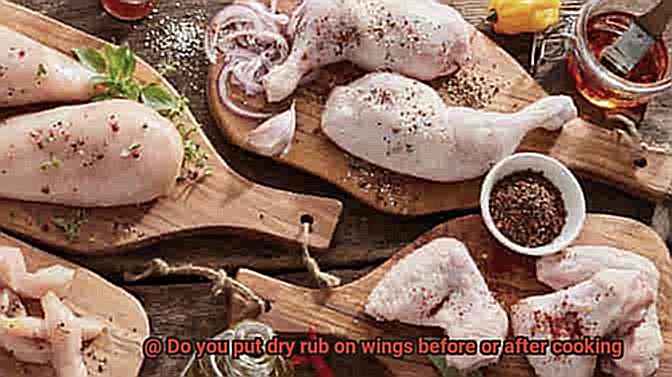
Disadvantages:
- The sugars in the rub can caramelize and char quickly if cooked over high heat.
- May not be as fresh and flavorful as applying after cooking.
Method #2: Apply the Rub After Cooking
If you’re worried about burning or bitterness from overcooking, then applying the dry rub after cooking may be a better option. This method helps prevent spices from burning or becoming bitter, especially when cooking over high heat. By waiting until after cooking to add the rub, you ensure that it stays fresh and flavorful. Additionally, this method can be easier to control spice levels.
Advantages:
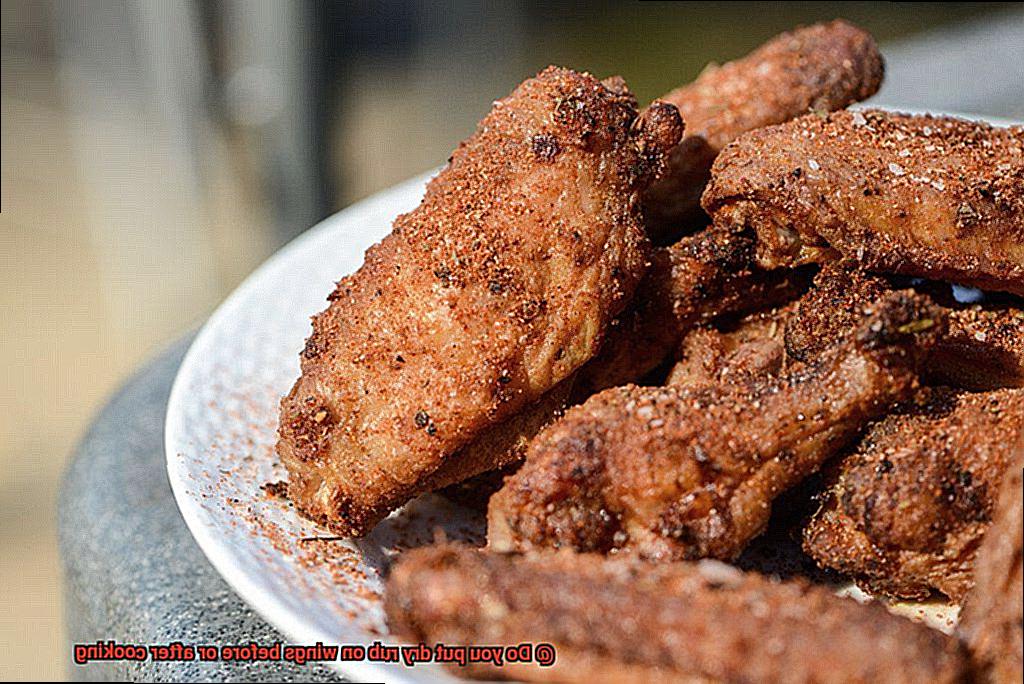
- Helps prevent spices from burning or becoming bitter.
- Ensures that the rub stays fresh and flavorful.
- Can be easier to control spice levels.
Disadvantages:
- May not penetrate as deeply into the meat.
- Does not tenderize the meat like pre-cooking application does.
How to Apply the Dry Rub?
Try applying a dry rub. A dry rub is a blend of spices and herbs that can add flavor and texture to your wings. However, applying the perfect dry rub requires a few key steps. Here are five sub-sections to follow to ensure that your wings are perfectly seasoned and crispy every time:
Dry the Wings
Before you start applying the dry rub, make sure your wings are completely dry. Excess moisture can prevent the rub from adhering properly to the meat. Pat them down with a paper towel or let them air dry for a few minutes after washing them.
Apply the Dry Rub
Generously apply the dry rub to both sides of the wings, using your hands or a brush to evenly distribute it. Be sure to cover every inch of the meat, so that each bite is flavorful.
Let it Sit
After applying the dry rub, let the wings sit for at least 30 minutes to allow the flavors to penetrate the meat. If you have time, you can let them sit in the rub overnight in the fridge for even more flavor.
Choose Your Cooking Method
When it comes to cooking your wings, you have options. Some people prefer to cook the wings with the rub still on, while others prefer to wipe off any excess rub before cooking. If you choose to leave the rub on during cooking, be aware that some of it may burn and become bitter. To prevent this, try indirect grilling or baking your wings in the oven.
Enjoy.
Once cooked, your wings should be deliciously flavored and crispy on the outside. Serve with your favorite dipping sauce and enjoy.
Remember, not all dry rubs are created equal. Some may contain salt, while others may not. If your dry rub contains salt, it is important to apply it sparingly as too much salt can draw out moisture from the meat and make it tough.
Considerations for Applying a Dry Rub
Before you dive headfirst into the world of rubs, there are several key considerations that you should keep in mind to ensure that your wings come out perfectly seasoned and mouthwatering.
First things first, timing is everything. When should you apply the rub – before or after cooking? Well, it ultimately depends on the type of rub being used and your personal preference. If you want the flavors to permeate the meat, applying the rub before cooking is the way to go. However, due to the smaller size of wings and their quick cooking time, it may not have enough time to fully penetrate if applied beforehand. On the other hand, if you’re using a rub with sugar or other ingredients that can burn easily, it’s best to apply it after cooking.
Another crucial consideration is how much rub to use. While you want to impart flavor into your wings, it’s essential not to overdo it. Too much rub can overpower the natural taste of the meat. A good rule of thumb is to use approximately 1 tablespoon of rub per pound of wings.
It’s also important to coat your wings evenly with the rub, ensuring that every nook and cranny is covered for maximum flavor. You can achieve this by using your hands or a brush.
Finally, don’t forget to let your wings rest after applying the rub. This allows all the flavors to meld together and intensify. A good resting time is about 30 minutes before cooking.
Tips for Applying a Dry Rub to Chicken Wings
Try applying a dry rub. A dry rub is a combination of herbs, spices, and other seasonings that can be applied to chicken wings before cooking. But how do you apply the rub correctly to ensure maximum flavor? Here are some tips to get you started.
Start with fresh, dry wings
Before applying the dry rub, make sure your wings are fresh and dry. Pat them down with a paper towel to remove any excess moisture. This will help the rub stick to the wings better.
Use enough rub and massage it in
Don’t be stingy with the dry rub. Make sure you apply enough to fully coat the wings and give them plenty of flavor. A good rule of thumb is about 1 tablespoon of rub per pound of chicken. Use your hands to massage the dry rub into the wings, making sure to cover every inch of the surface area. This not only helps distribute the flavor evenly but also helps the rub adhere to the chicken.
Let it sit for at least 30 minutes
Once you’ve applied the dry rub, let the wings sit for at least 30 minutes (or up to overnight) in the refrigerator. This allows the flavors to penetrate the meat and results in a more flavorful end product.
Pat off excess
Before grilling or cooking, make sure to pat off any excess dry rub from the wings. Too much rub can cause the chicken to burn or become overly salty.
Cook at the right temperature
To ensure perfectly crispy and flavorful wings, cook them at 375 degrees Fahrenheit for 25-30 minutes. Using a rack can help promote even cooking and crispy skin on all sides.
e6yZaY4IMPw” >
Conclusion
To sum it up, dry rubs are a game-changer when it comes to chicken wings. The decision on whether to apply the rub before or after cooking depends on your personal preference and cooking style. Pre-cooking application allows the flavors to seep into the meat, while post-cooking application prevents spices from burning or turning bitter. Regardless of your choice, ensure that you use high-quality dry rubs and apply them uniformly for maximum flavor.
The world of dry rubs for chicken wings is vast and diverse, with each type having its own unique flavor profile. From sweet and spicy to smoky and tangy, there’s a perfect dry rub out there for everyone. Experiment with different spice combinations until you find the one that suits your taste buds best.
Timing is crucial when applying a dry rub. Make sure your wings are fresh and dry before coating them evenly with the rub. Let them sit for at least 30 minutes before grilling or cooking, pat off any excess before cooking, and cook at the right temperature for crispy and flavorful wings.
Overall, using a dry rub on your chicken wings elevates their taste, adds texture, keeps them moist, and is a healthier option than using sauces.

